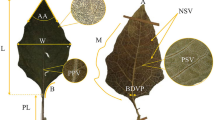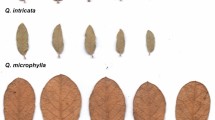Abstract
To better understand the patterns of variability and distributions ofHemerocallis in Korea, 53 locations were visited and measurements of 19 morphological and phenological characters were taken on plants directly from their natural habitats. For morphometric analysis, 10 plants from each of 34 populations and five herbarium specimens ofH. middendorffii were used and the data from 12 quantitative characters was analyzed using univariate analysis. Except the littoral populations of Cheju, Hong, Taehuksan, and Sohuksan Islands (H. hongdoensis M. Chung & S. Kang), three peninsular KoreanHemerocallis species can be recognized mainly in South Korea:H. hakuunensis Nakai (=H. micrantha Nakai, growing on southern, central, and northwestern Korea);H. thunbergii Baker (=H. coreana Nakai, found on southeastern and central Korea); andH. middendorffii Tr. et Mey. (central and northeastern Korea). Morphological and phenological features contributing to recognition of the three groups were; color of perianth, shape of roots, shape of inflorescence, flowering time, odor, length of inflorescence, width of the lowest bracts, length of perianth tube enclosing a ovary, width of the inner perianth lobes. Natural hybridization seems to be rare in KoreanHemerocallis. It appears that the KoreanHemerocallis species are relatively well characterized by their distribution patterns, phenology, and habitats compared with the JapaneseHemerocallis species.
Similar content being viewed by others
References
Balley, L. 1930.Hemerocallis: the day-lilies. Gentes Herb.2: 143–156.
Bruederlf, L.P., Fairbrothers, D.E. andHanks, S.L. 1989. A systematic circumscription ofCarex mitchelliana (Cyperaceae) with reference to taxonomic status. Amer. J. Bot.76: 124–132.
Chung, M.G., Jones, S.B., Hamrick, J.L. andChung, H.G. 1991. Morphometric and isozyme analysis of the genusHosta (Liliaceae) in Korea. Plant Species Biol.6: 55–69.
Chung, M.G. and Kang, S.S. 1994.Hemerocallis hongdoensis (Liliaceae), a new species from Korea. Novon4: (in press).
Cohen, S. 1986. The well-tinkered daylily. Garden Sept./Oct. 16–19.
Flint, R.F. 1971. Clacial and Quaternary Geology. John Wiley and Sons, Inc., New York.
Fujita, N. 1976. The genusHosta (Liliaceae) in Japan. Acta Phytotax. Geobot.27: 66–96. (in Japanese)
Hara, H. 1941. Observations ad plantas Asiae orientalis (XVIII). J. Jap. Bot.17: 127.
Hotta, M., Ito, M. andOkada, I. 1985. Differentiation and species relationships of island populations ofHemerocallis around Kyushu, Japan.In H. Hara, ed., Origin and Evolution of Diversity in Plants and Plant communities, 18–31, Acad. Sci. Book Inc., Tokyo.
Hotta, M. 1986.Hemerocallis aurantiaca group in northern Kyushu, Japan. Acta Phytotax. Geobot.37: 17–21. (in Japasese)
Kawano, S. 1961. On the natural hybrid population ofHemerocallis. Can. J. Bot.39: 667–681.
Kitamura, S., Murata, G. andKoyama, T. 1986. Colored Illustrations of Herbaceous Plants of Japan (Monocotyledoneae). Hoikusha Publ. Co., Ltd., Osaka, Japan. (in Japanese)
Lee, T.B. 1985. Illustrated Flora of Korea. Hyangmoonsa, Seoul. (in Korean)
Masuo, M. 1984. Translation: Flowers of Tsushima Island: Flora of Land-bridge Island I. Ashisyobo Co., Ltd., Fukuoka, Japan. (in Japanese)
Matsuoka, M. andHotta, M. 1966. Classification ofHemerocallis in Japan and it's vicinity. Acta Phytotax. Geobot.22: 25–43. (in Japanese).
Nakai, T. 1932.Hemerocallis Japonica. Bot. Mag. Tokyo46: 111–123.
Nakai, T. 1943. Notulae ad plantas Asiae orientalis (XXVIII). J. Jap. Bot.19: 315–316.
Nakao, S. and Yamashita, K. 1956. Variation in some plant populations.In T. Komai and K. Sakai, eds., Syundan Idengaku (Population Genetics), 249–254, Tokyo. (in Japanese)
Noguchi, J. 1986. Geographical and ecological differentiation in theHemerocallis dumortieri complex with special reference to its karyology. J. Sci. Hiroshima Univ. Ser B. Div. 2, Bot.20: 29–193.
Ohba H., Ishii, N. and Saito, S. 1987. Translation: Biogeography of Tsushima Island. Report on the natural resource investigation of Tsushima island: Nature of Tsushima Island, Nagasaki Pref., Japan, 259–271. (in Japanese)
Ohba, H. and Midorikawa, K. 1987. Translation: Some remarks of the flora of Tsushima Island, NW Kyushu, Japan. Report on the natural resource investigation of Tsushima Island: Nature of Tsushima Island, Nagasaki Pref., Japan, 63–78. (in Japanese)
SAS Institute Inc. 1987. SAS/STAT Guide for Personal Computers, ver. 6 ed. SAS Inst. Inc., Cary, NC.
Stout, A.B. 1934. Daylilies. Macmillian Co., New York.
Stout, A.B. 1941. Memorandum on a monograph of the genusHemerocallis. Herbertia8: 67–71.
Takenaka, Y. 1952. Karyotypes and sterility inHemerocallis. Coordinating Comm. Res. Genet.3: 71–90.
Author information
Authors and Affiliations
Rights and permissions
About this article
Cite this article
Chung, M.G., Kang, S.S. Morphometric analysis of the genusHemerocallis L. (Liliaceae) in Korea. J. Plant Res. 107, 165–175 (1994). https://doi.org/10.1007/BF02346013
Received:
Accepted:
Issue Date:
DOI: https://doi.org/10.1007/BF02346013




